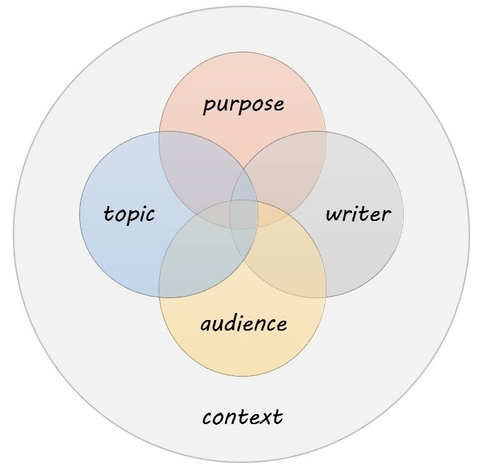The Rhetorical Situation
A piece of writing is shaped and influenced by its surrounding circumstances and contexts. The rhetorical situation can be described in five parts: purpose, audience, topic, writer, and context. These parts work together to better describe the circumstances and contexts of a piece of writing, which if understood properly, can help you make smart writing choices in your work. See our handouts on context and audience for more information.
NOTE: The rhetorical situation is based loosely on the rhetorical triangle. The purpose and the topic create the text while the audience and writer make up the other two parts.

The Parts of the Rhetorical Situation
purpose
Consider what the purpose of the writing is. Are you writing to inform, evaluate, analyze, or convince? Each of these purposes carries specific conventions and dictates how the writing will be formed.
audience
When writing anything, consider who is being addressed. Audiences bring in their own perspectives, biases, experiences, and expectations, which can make writing for a particular audience difficult.
topic
The topic is the content of your writing. The topic may be self-selected or assigned, but writers should try and find an angle that they are motivated to write about. The topic should also be broad enough to fit the assignment’s parameters and specific enough to go into detail.
writer
Writers, just like their audience, are influenced by a number of things, like their age, locations, perspective, bias, culture, experiences, and expectations. Writers may need to consider whether the traits they are bringing in will have a positive or negative outcome on their audience. For example, even if you are particularly passionate about a topic, you may have to show restraint in expressing those views to more effectively convince an audience. Your writing must connect with your target audience if you want to successfully motivate change.
context
The context describes the circumstances surrounding the writing, which include the time (when the text was written), location (blog, academic journal, etc.), and the culture surrounding the text.
Example
Sometimes your rhetorical situation can be quite complex, especially when school assignments ask you to write in different contexts for an unfamiliar audience. In these situations, you might wonder who the audience is—the audience that is written on the page or your instructor? In these cases, you will have to balance your teacher’s expectations and still conform to the expectations of the imagined audience. Below is an example of a prompt and how the rhetorical situation is broken down for it.
Prompt: You are in a composition 101 course, and your assignment asks you to write an evaluation of an argumentative article of your choice by rhetorically analyzing the decisions the author has made. Based on this evaluation, argue why the article is or isn’t convincing for its intended audience. This evaluation should directly respond and engage with the author who wrote the article.
purpose
This writing assignment’s purpose is to evaluate a piece of writing rhetorically. Since this paper is meant to engage with the writer of the article, an underlying purpose would likely be to offer constructive feedback on what they have written in a respectful way.
audience
In this case, the audience will be the author of the article you have chosen to read. This means you will have to frame your criticisms carefully so you do not upset your reader or give the wrong impression. Consider your instructor as a secondary audience because while they have asked that you write to this specific person, your instructor will ultimately be grading your work based on the requirements of the assignment.
topic
The topic of this paper is just one argumentative article and how well that article articulates its argument to its intended audience. This topic is narrow, but it also provides many avenues to explore, in detail, the author’s rhetorical choices.
writer
With this college level assignment, you are asked to interact with someone who has published their work in a professional setting. As a college student, this could be intimidating considering that most college students may not have much experience engaging with rhetorical concepts and evaluating professional writers. However, this assignment is the perfect opportunity for you to present yourself in your writing as a professional student who is thoughtful and critically engaged.
context
No piece of writing exists in a vacuum, but is always a piece of all that exists around, what has come before and what will follow. This paper exists within the culture of your university, of American culture, of scholarly writing, and of the contemporary milieu. These factors will influence the way your paper is evaluated.


